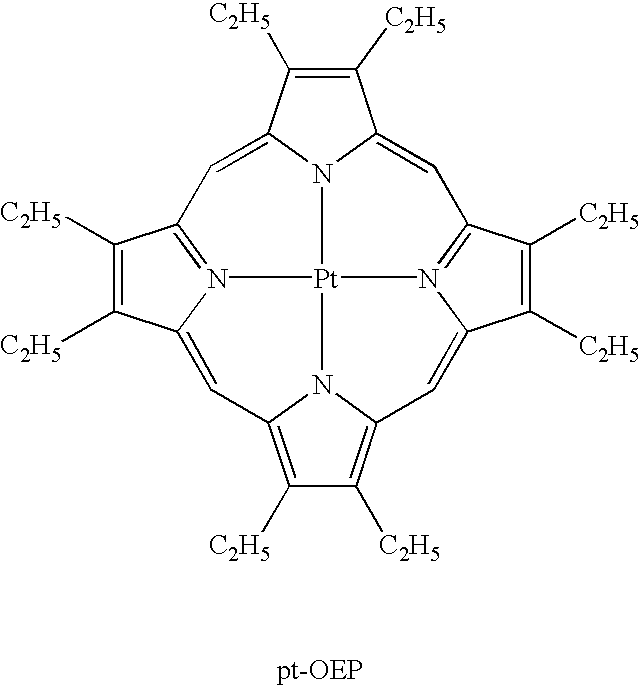Luminescence device and metal coordination compound therefor
a technology of luminescent devices and metal coordination compounds, which is applied in the direction of discharge tube luminescnet screens, natural mineral layered products, etc., can solve the problems of luminescent deterioration and utilization of phosphorescen
- Summary
- Abstract
- Description
- Claims
- Application Information
AI Technical Summary
Benefits of technology
Problems solved by technology
Method used
Image
Examples
example 12 (
SYNTHESIS OF COMPOUND 2)
##STR19##
In a 3 liter-three necked flask, 14.6 g (90.6 mM) of 2-(2-thienyl)pyridine and 912 ml of anhydrous ether were placed and stirred at -70.degree. C. or below in an argon gas stream. To the mixture, 62.2 ml (99.5 mM) of 1.6M-t-butyllithium solution in pentane was added dropwise in ca. 35 min., followed by stirring at -70.degree. C. for 40 min. At that temperature, a suspension of 8.5 g (19.0 mM) of cis-PtCl.sub.2 [(C.sub.2 H.sub.5).sub.2 S].sub.2 in a mixture solvent of 289 ml of anhydrous ether and 73 ml of tetrahydrofuran (THF) was added dropwise in ca. 1 hour to the resultant mixture, followed by stirring at -70.degree. C. for 30 min. and a gradual temperature rise up to 0.degree. C. in ca. 2 hours. To the reaction mixture, 912 ml of water was gradually added dropwise at 0.degree. C. The organic layer was washed with common salt aqueous solution and the aqueous (water) layer was subjected to extraction with methylene chloride. The resultant organic l...
example 13 (
SYNTHESIS OF COMPOUND 5)
##STR20##
In a 1 liter-three necked flask, 26.6 g (168.5 mM) of 2-bromopyridine, 30.0 g (168.5 mM) of benzo[b]thiophene-2-boronic acid, 170 ml of toluene, 85 ml of ethanol and 170 ml of 2M-sodium carbonate aqueous solution were placed and stirred in a nitrogen gas stream at room temperature. Under stirring, to the mixture, 6.18 g (5.35 mM) of tetrakis(triphenyl-phosphine) palladium (0) was added, followed by heat-refluxing for 5.5 hours under stirring in a nitrogen gas stream.
After the reaction, the reaction mixture was cooled, followed by extraction with cool water and toluene. The organic layer was washed with water until the system showed neutral, followed by distilling off the solvent under reduced pressure to obtain a residue. The residue was purified by silica gel column chromatography (eluent: toluene / hexane=5 / 1) to obtain a colorless crystal. The crystal was purified by alumina column chromatography (eluent: toluene) and recrystallized from ethanol to ...
example 14 (
SYNTHESIS OF COMPOUND 3)
##STR22##
In a 3 liter-three necked flask, 35.0 g (112 mM) of 2,2'-dibromobiphenyl and 650 ml of anhydrous ether were placed and stirred at -60.degree. C. or below in an argon gas stream. To the mixture, 153 ml (0.245 mM) of 1.6M-n-butyllithium solution in pentane was added dropwise in ca. 50 min., followed by a temperature rise and stirring at room temperature for 3 hours. To a suspension of 25.0 g (56.0 mM) of cis-PtCl.sub.2 [(C.sub.2 H.sub.5).sub.2 S].sub.2 in 833 ml of anhydrous ether cooled and kept at .+-.10.degree. C. or below, the resultant mixture was added dropwise in ca. 10 min., followed by stirring at -10.degree. C. for 1 hour and a gradual temperature rise up to 0.degree. C. To the reaction mixture, 417 ml of water was gradually added dropwise at 0.degree. C. The organic layer was washed with a common salt aqueous solution and the aqueous (water) layer was subjected to extraction with methylene chloride. The resultant organic layer (from the orga...
PUM
| Property | Measurement | Unit |
|---|---|---|
| thickness | aaaaa | aaaaa |
| luminance | aaaaa | aaaaa |
| area | aaaaa | aaaaa |
Abstract
Description
Claims
Application Information
 Login to View More
Login to View More - R&D
- Intellectual Property
- Life Sciences
- Materials
- Tech Scout
- Unparalleled Data Quality
- Higher Quality Content
- 60% Fewer Hallucinations
Browse by: Latest US Patents, China's latest patents, Technical Efficacy Thesaurus, Application Domain, Technology Topic, Popular Technical Reports.
© 2025 PatSnap. All rights reserved.Legal|Privacy policy|Modern Slavery Act Transparency Statement|Sitemap|About US| Contact US: help@patsnap.com



